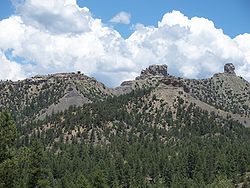- Chimney Rock Archeological Site
-
- This is an article about Chimney Rock Archaeological Site in Colorado. For the Chimney Rock in Nebraska, see Chimney Rock National Historic Site
Chimney Rock Archeological SiteChimney RockLocation: Archuleta County, Colorado Nearest city: Chimney Rock, Colorado Coordinates: 37°11′30″N 107°18′23″W / 37.1917°N 107.3064°WCoordinates: 37°11′30″N 107°18′23″W / 37.1917°N 107.3064°W Governing body: United States Forest Service NRHP Reference#: 70000153 [1] Added to NRHP: August 25, 1970 The Great Kiva was believed to have been built circa 1084 as part of the Chimney Rock settlement. Originally, it would have had an adobe plaster exterior. It was rebuilt in 1972.
Chimney Rock Archaeological Area is an archeological site within the San Juan National Forest in Colorado. This area is located in Archuleta County, Colorado between Durango and Pagosa Springs and is managed for archaeological protection, public interpretation, and education.
Contents
Geography
Chimney Rock lies on 4,100 acres (17 km²) of San Juan National Forest land surrounded by the Southern Ute Indian Reservation.
History
Listed on the National Register of Historic Places in 1970, the site was home to the ancestors of the modern Pueblo Indians 1,000 years ago and is of great spiritual significance to these tribes. Their ancestors built over 200 homes and ceremonial buildings high above the valley floor, probably to be near the sacred twin rock pinnacles. Of the hundreds of individual sites dotting the landscape, researchers have thus far found 91 structures that may have been permanent structures, plus 27 work camps near farming areas, adding up to more than 200 individual rooms.[2] Housing approximately 2,000 ancient Pueblo Indians between A.D. 925 and 1125, the settlement included a Great House with round ceremonial rooms, known as kivas, and 36 ground-floor rooms.
Since the 1960s, Dr. Frank Eddy of the University of Colorado and others have studied the site, and research continues.[2]
National Forest Service
Its care, protection, and preservation are shared by the Pagosa Ranger District, United States Forest Service and the public, who contribute through tour fees, donations, and purchase of items from the Chimney Rock Visitor's Center. The Chimney Rock Interpretive Program, managed and staffed by the National Forest Service and volunteers of the Chimney Rock Interpretive Association, conducts daily guided walking tours and operates the Visitor Center during in-season, May 15 to September 30.[2]
See also
- List of prehistoric sites in Colorado
References
- ^ "National Register Information System". National Register of Historic Places. National Park Service. 2006-03-15. http://nrhp.focus.nps.gov/natreg/docs/All_Data.html.
- ^ a b c "Chimney Rock Archaeological Area". http://www.chimneyrockco.org/.
External links
U.S. National Register of Historic Places Topics Lists by states Alabama • Alaska • Arizona • Arkansas • California • Colorado • Connecticut • Delaware • Florida • Georgia • Hawaii • Idaho • Illinois • Indiana • Iowa • Kansas • Kentucky • Louisiana • Maine • Maryland • Massachusetts • Michigan • Minnesota • Mississippi • Missouri • Montana • Nebraska • Nevada • New Hampshire • New Jersey • New Mexico • New York • North Carolina • North Dakota • Ohio • Oklahoma • Oregon • Pennsylvania • Rhode Island • South Carolina • South Dakota • Tennessee • Texas • Utah • Vermont • Virginia • Washington • West Virginia • Wisconsin • WyomingLists by territories Lists by associated states Other Categories:- Native American history of Colorado
- Protected areas of Archuleta County, Colorado
- Rock formations in Colorado
- National Historic Sites in Colorado
- Ancient Puebloan archaeological sites in Colorado
- Native American archeology
- Religious places of the indigenous peoples of North America
- United States archaeology stubs
- Colorado geography stubs
Wikimedia Foundation. 2010.


